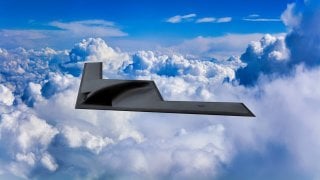B-21 Raider: The Bomber Russia Has No Chance of Matching Anytime Soon
The Northrop Grumman B-21 Raider is progressing steadily to become the backbone of the U.S. Air Force's bomber fleet, poised to replace the aging B-1B Lancer and B-2 Spirit.
4 Key Points: The Northrop Grumman B-21 Raider is progressing steadily to become the backbone of the U.S. Air Force's bomber fleet, poised to replace the aging B-1B Lancer and B-2 Spirit.

-Designed as the "air leg" of America's nuclear triad, the B-21 aims to deter conflicts with near-peer adversaries like China and Russia.
-Recent updates from the Air and Space Force Association's conference highlight successful structural tests and increased flight test frequencies.
-The Air Force plans to acquire at least 100 B-21 Raiders, with Ellsworth Air Force Base in South Dakota as the first main operating base. Additional bases include Whiteman AFB in Missouri and Dyess AFB in Texas, ensuring the B-21's strategic global presence.
B-21 Raider: Strengthening the Nuclear Triad Against Near-Peer Threats
The Northrop Grumman B-21 Raider remains on track to be the backbone of the United States Air Force's bomber fleet, and will "incrementally replace" the Rockwell B-1B Lancer and Northrop B-2 Spirit in the coming decade – serving as the "air leg" of America's nuclear triad, which remains critical to deterring conflict with near-peer adversaries.
Yet, there have been concerns about the efforts to develop and produce the flying-wing aircraft quickly enough and in significant numbers. Some of the concerns were recently laid to rest.
Tests Continue at a Steady Pace for B-21
At last week's Air and Space Force Association's Air, Space and Cyber Conference, officials from the Department of the Air Force and industry partners provided an update on the state of the B-21 Raider program.
"We're really starting to strike up quite a cadence [and] generate two flight test flights in a given week," explained Thomas Jones, Northrop Grumman Aeronautics Systems sector president. "When we started this journey, we made a vow that we were going to design this system to be a daily flyer. It's been a phenomenal year of progress, and we hope to continue that through the next year."
It was further announced that the B-21 "completed its static test on the G-1 asset, a ground-based test article used to evaluate the structural integrity of the aircraft."
According to William Bailey, director of the Department of the Air Force Rapid Capabilities Office, "[The test was essential to] confirming the structural design of the aircraft is sound and validated in the digital models."

Testing on the B-21 Raider will continue, with the next focus on "fatigue testing."
"We're very clear as a team what the priorities are day after day," Bailey added. "That collaboration between operators and acquirers has been a key component of this success … that has got to be a consideration [in Great Power Competition]."
The U.S. Air Force is still calling for a fleet of at least 100 B-21 Raiders, although some officials have suggested the U.S. military needs at least double that number given the potential global threats, and to ensure that the aircraft aren't pushed too hard – which occurred with the B-1 and B-2s.
"We are the free world's only bomber force," noted Gen. Thomas Bussiere, Air Force Global Strike Command commander.
"We're probably not going to see a decreased demand signal from our regional combatant commands on bomber task forces," Bussiere added. "That demand signal, in my opinion, is only going to go up in the years ahead. As we transition from legacy to new, the B-21 fleet will provide great comfort to our allies and should provide great pause to any potential adversary."
Future Homes for the Raiders
When the B-21 Raider formally enters service later this decade Ellsworth Air Force Base (AFB), South Dakota, will become the first Main Operating Base, as well as the formal training unit for the bomber fleet.
Earlier this month, Secretary of the Air Force Frank Kendall also announced that the second and third basing locations for the Air Force's newest bomber had been approved. As expected, those bases include Whiteman AFB, MO; and Dyess AFB, TX, in that order. Each will receive aircraft as they become available.

Like Ellsworth, Dyess AFB is a home base for the B-1B Lancer; while Whiteman AFB is the current home of the U.S. Air Force's fleet of 19 B-2 Spirits.
When the bombers will arrive at Dyess and Whiteman remains unknown, but the Raider entered low-rate initial production (LRIP) earlier this year. That will ensure the B-21 Raider is in service before near-peer adversaries including China and Russia will see their expected stealth bombers take to the skies in significant numbers – if even at all in Russia's case.
"Nobody on the planet can do what we're doing right now," suggested Bussiere. "Nobody on the planet can build an exquisite, technologically-advanced platform like the B-21, and quite frankly, nobody on the planet can hold at risk what we can hold at risk at a time and place of our choosing."
Author Experience and Expertise: Peter Suciu
Peter Suciu is a Michigan-based writer. He has contributed to more than four dozen magazines, newspapers, and websites with over 3,200 published pieces over a twenty-year career in journalism. He regularly writes about military hardware, firearms history, cybersecurity, politics, and international affairs. Peter is also a Contributing Writer for Forbes and Clearance Jobs. You can follow him on Twitter: @PeterSuciu. You can email the author: [email protected].
Image Credit: Creative Commons and/or Shutterstock.


